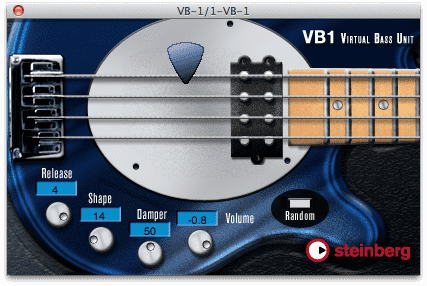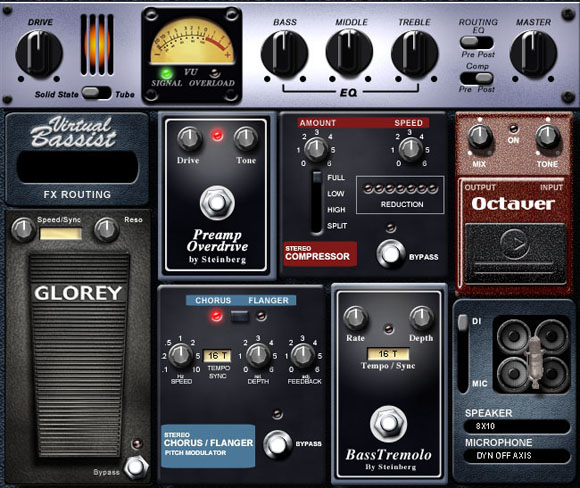
- Steinberg Virtual Bassist Mac
- Steinberg Virtual Bassist For Mac Os
- Steinberg Virtual Bassist For Macbook Pro
- Steinberg Virtual Bassist For Macbook

Steinberg’s Virtual Bassist and Virtual Guitarist II plug-ins are useful tools if you’ve got a musical blueprint in your head, want some inspiration to fill in the details, and you’re not the ‘perfect’ guitar or bass player. Both packages build their functionality not on presequenced MIDI data triggering a sample library, but on real bass and guitar tracks modeled after actual performances. MIDI is used merely to let you quickly choose variations and tailor the performances to your liking.
- Steinberg Virtual Bassist Software VST Preset Generator v.0.2.3 VST Preset Generator is a software to create randomly (or semi-randomly) generated presets for your favorite VST instruments and effects.
- VB-1 is a virtual bass emulation with selectable pick position. Features: 4 voice polyphonic. Damper, PickUp position, Pick position, & Wave Morph controls. Responds to Pan.
The instruments are sold separately, but since their approach and operation are nearly identical, both are reviewed here. They’re Mac- and PC-compatible, and operate as ReWire capable standalone programs or Audio Units/VST/DXi2 plug-ins. Virtual Bassist uses a little less than 600 megabytes of space on your drive, but Virtual Guitarist II will need nearly 7 GB to accommodate its massive amount of variety. Copy protection is handled by a separately sold dongle, unless you’re using Cubase or Nuendo.

Steinberg Virtual Instrument SE With 5 professional quality powerful virtual instruments at one attractive low price, the Steinberg Virtual Instruments Collection is the perfect addition to any computer music studio, regardless of whether you're a novice or a professional. Protection scheme. Virtual Bassist will not run if there is no Steinberg Key present or if this key has not been properly activated. You can ei-ther separately purchase a new Steinberg Key for use with Virtual Bass-ist, or use a key previously bought for use with a Steinberg application.
Virtual Bassist GUI showing important tone-shaping controls, including dynamics, tone and feel settings.
STYLES, RIFFS AND FX
I found the nearly identical interfaces easy to use. Three primary pages are selected by clicking tabs near the top of the interface. The Play tab focuses on selecting musical genres and corresponding variations called Styles and Parts. Styles are selected from a list on the interface’s right side. This list can be changed to a Part display, where you can choose a specific variation of the Style by clicking or by playing mapped keys on an area of your MIDI controller, referred to as the Remote Range. Another two-octave range of your controller is used to play chords in real time so your virtual musicians know which notes to play.
The second tab — Riff in Virtual Guitarist 2 and Groove Match in Virtual Bassist — tailors any Part to your liking. The editor is laid out like a piano-roll editor. This is perfect for when the bass part’s accents aren’t quite matching the kick drum.
The FX tab provides a variety of virtual processing capabilities using what looks like a custom pedal board. This includes amp and cabinet emulators, compressors, wah pedal, tremolo and, for the bassist, an octaver. Presets for the effects are selected automatically to suit the type of style you’re using, or you can choose your own presets independently. A nice feature is that these virtual effects can be used as a separate plug-in.
GET UP AND GO
Installing and authorizing both programs took about 20 minutes and went off without a hitch. While installing them, I perused the manual and was delighted to find a well-thought-out guide that provided technical details and useful suggestions.
Using Apple Logic Pro 7 as my host software, I brought up a groovin’ drum loop. On another track loaded with the Virtual Bassist Audio Units plug-in, I browsed through the roughly 30 Styles available. Using the Listen button, I was able to audition the various Styles quickly, with great-sounding pre-programmed examples. I found a Style called Slappy that had the feel I was looking for. I was still skeptical about how well things would work over my drum loop with my chords, but I hit Play in Logic and tried playing the chords with my right hand while triggering the various Part variations with my left. Through no fault of the software, this didn’t work well; I needed more time to get comfortable with this approach and to memorize the 19 Part and Fill variations. What worked best for me was to play the chords on another track with a basic piano sound. This track became the chord chart from which my virtual players could follow.
Virtual Guitarist 2 Play tab with 87 styles listed on the right, including Reggae Chops, Brit Pop 2 and many more.
I then copied my “chart” to the bass track. This freed me to listen to the Virtual Bassist play the chords while I focused on choosing the various Parts by pressing keys in the remote range. To make it even more lifelike, I turned up the Variance control, which allows for timing randomization. Within minutes, I had an extremely natural-sounding line that grooved hard and, most importantly, did not sound programmed.
The FX tab gave me tools to tweak the bass sound, but for me, some of the most important tone-shaping controls are found back on the Play page. Just like asking the bassist to switch pickups, the left side of the bass interface screen allows you to slide the pickup position closer to the neck or bridge. There’s even a control to model vintage or modern basses. One of my favorite features is the dampening knob, which provides an open or muted sound.

Because Virtual Guitarist 2 works the same way as Virtual Bassist, getting up to speed went much more quickly. Whereas a lot of guitarists tend to specialize in a musical genre, Virtual Guitarist 2 comes with 87 styles, including names such as Reggae Chops, Brit Pop 2, Folk Picking and 12-String Strumming. There are acoustic, electric, and even mandolin and dobro Parts, but because these are played with real players, you cannot use an acoustic guitar style with an electric sound. With almost too many options, I quickly had the Audition button working overtime.
Although it wasn’t what I originally had in mind, I stumbled across a great-sounding nylon-string guitar Style called Gypsy Grooves. I decided to see how that might sit in the song, so I copied the original chord sequence from the piano into the nylon guitar track and was instantly impressed. After a quick pass to lay down the Part variations, I was astounded by how quickly the track came together and sounded great. Another great feature is the ability to double the track. Clicking this switch made it sound like there was an actual second pass on the guitar line; this is much more convincing than typical doubling effects.

Although I loved the nylon guitar, literally a click of the mouse in the Style list is all it took to change everything to the clean funk sound I originally had in mind. All of the Part variations I had selected for the nylon guitar translated perfectly to the new electric part. Using a clever Inversion control, I was able to raise the part to a higher register, just like asking a real guitarist to play a different inversion of a chord.
GET YOUR GROOVE ON
Virtual Bassist and Virtual Guitarist 2 are easy to use, and once you learn one, the learning curve when jumping to the other is minimal. Because the collection’s sample base is built on real performances, the sounds are easy to pass as the real deal. The doubling effect is great, as is the ability to quickly audition your Part with a different Style or instrument. This collection is great for the pro looking to dress up demos or give an extra edge of real feel to any track.
Steinberg, 877/253-3900, www.steinberg.net.
Steinberg Virtual Bassist Mac
Robert Brock is an educator, author, MIDI guru and father of 2-year-old rock star Sebastian Brock.
Adjust the timing and feel in the Micro panel. When the From MIDI function is enabled, Virtual Bassist analyzes incoming MIDI data and adjusts the phrase’s micro-timing accordingly.
Steinberg Virtual Bassist For Mac Os
Users can opt to record via a DI box or microphone, and select among various microphone types/placements, as well as six speaker cabinets. The Multi-Effect Board may also be used as an effects plug-in in the host application.
Steinberg Virtual Bassist For Macbook Pro
The new Part Editor lets users revise and revamp every phrase rendered by Virtual Guitarist 2. And every slice can be moved, deleted, muted and transposed at will.
Steinberg Virtual Bassist For Macbook
For added sound-shaping power, Virtual Guitarist 2 now offers three different types of amps and four speaker models, as well as two microphones and two mic positioning options.